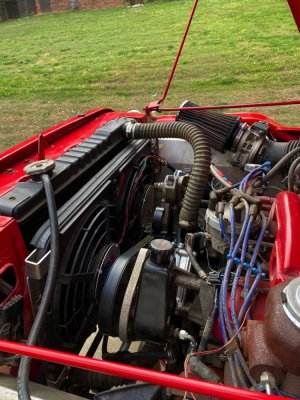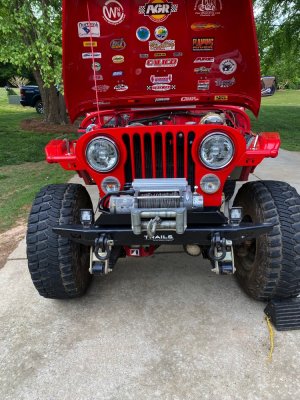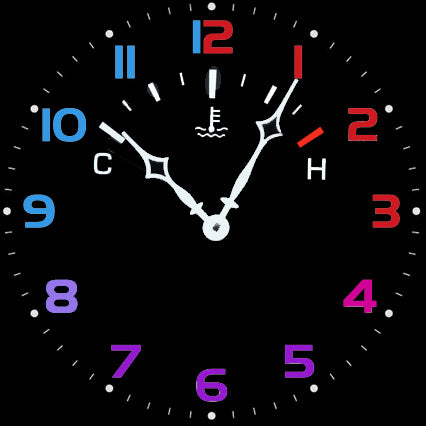viper red cj-7
Well-Known Member
- Joined
- Apr 5, 2005
- Location
- charlotte
Hey all,
Looking for guidance. I'm not a mechanic, so keep that in mind!
Mustang 302 (88) into my CJ. I can't seem to keep temps down at all. Wife and I just took ~25 minute ride- temps creeped up north of 230 degrees.
Motor is basically stock- not hopped up at all.
What I've done.
Dual fan with Flex lite controller. The controller is supposed to come on ~165-170 at 1/2 speed which I'm pretty sure it does, then at 10% above that, it's supposed to come on at 100%
Had my PS cooler changed from mount on radiator (flat cooler) to what you see in the pic by Winch.
Had winch control box moved to under hood
Recently replaced thermostat (165 degree), new high flow water pump, radiator was pulled to fix small crack (was welded / brazed), pressure tested and put back in..
My thoughts:
Is the 165 deg thermostat appropriate? Should it be 185/190?
Was told to put a shroud (?) around my K&N air filter to block the heat
I could put some dimple die (?) holes in my inner fenders
I really don't want to poke holes in the hood of the CJ. I know I can get a bolt in louver set from GR / PSC or whoever, but really want that as last resort
Thoughts on aluminum radiator?
What am I missing??
thanks!
Looking for guidance. I'm not a mechanic, so keep that in mind!
Mustang 302 (88) into my CJ. I can't seem to keep temps down at all. Wife and I just took ~25 minute ride- temps creeped up north of 230 degrees.
Motor is basically stock- not hopped up at all.
What I've done.
Dual fan with Flex lite controller. The controller is supposed to come on ~165-170 at 1/2 speed which I'm pretty sure it does, then at 10% above that, it's supposed to come on at 100%
Had my PS cooler changed from mount on radiator (flat cooler) to what you see in the pic by Winch.
Had winch control box moved to under hood
Recently replaced thermostat (165 degree), new high flow water pump, radiator was pulled to fix small crack (was welded / brazed), pressure tested and put back in..
My thoughts:
Is the 165 deg thermostat appropriate? Should it be 185/190?
Was told to put a shroud (?) around my K&N air filter to block the heat
I could put some dimple die (?) holes in my inner fenders
I really don't want to poke holes in the hood of the CJ. I know I can get a bolt in louver set from GR / PSC or whoever, but really want that as last resort
Thoughts on aluminum radiator?
What am I missing??
thanks!






